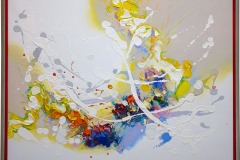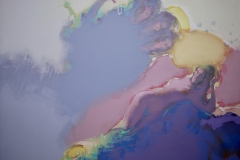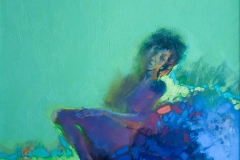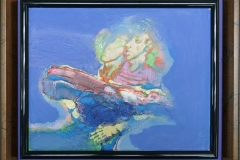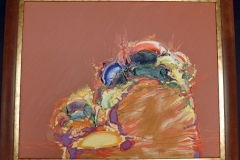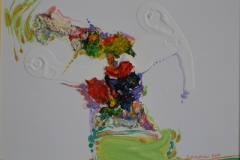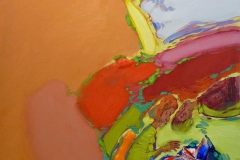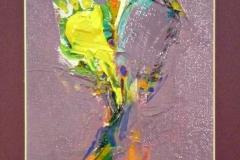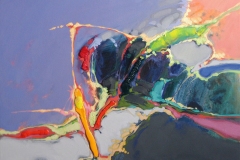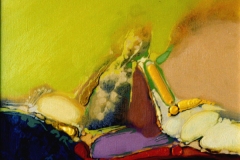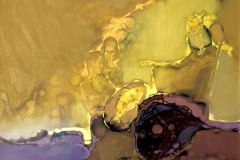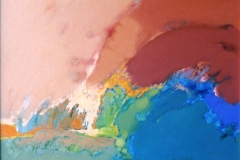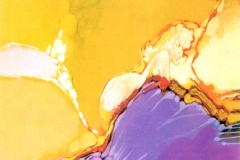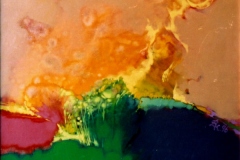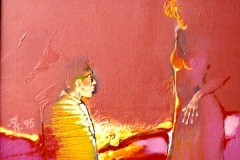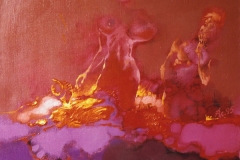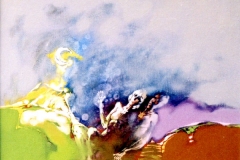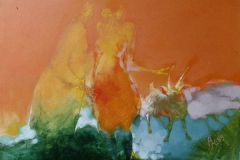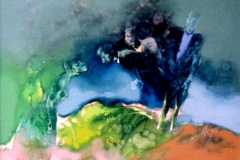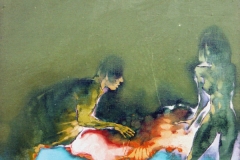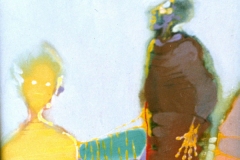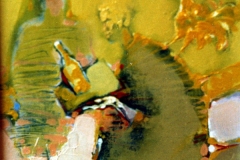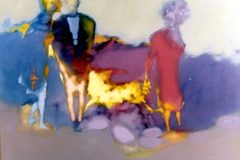Oil Colors
The Cycles of Vesselin Kourtev:
Resonance 2024
Resonance explores how colors blend, bleed, and cross each other’s boundaries in order to create a specific narrative. The paint throughout this cycle drips with spontaneity, allowing the canvas to take on a shape of its own. Kourtev’s paintings consist of intricately drawn figures that seem ghostlike as they fade into the canvas. Themes of interpersonal relationships, human connection, and deep emotion are present across each intricate piece. The intention behind each painting is to persuade its audience to explore broader concepts of existence, as well as identify, through the nuance and abstraction of this cycle. Resonance contains similarities to previous cycles, but ultimately stands alone, as Kourtev includes elements of three-dimensionality, spontaneity, and paint splatter. Kourtev’s impressive evolution as an artist is evident through the newfound techniques he effectively implements throughout Resonance.
Chasing Memories: A Vesselin Retrospective 2023
Vesselin’s subject matter includes the human form, capturing human relationships and interactions in global and personal dimensions. His work takes on an abstract style, creating environmental reconstruction. The state of the figures conveys Vesselin’s message, and their faces are reinforced with reserved gestures and movements.
Phantasia: Expressions of Love 2022
Experimenting with otherworldly colors, abstract symbols, and dream-like imagery, Kourtev’s art allows viewers to enter into his imagination and to access realms of their own fantastical imaginings. Throughout his artwork, Kourtev utilizes a vibrant palette of pastel colors that work to transport viewers into technicolor worlds of their imagination. In each of his individual canvases, Kourtev overlays meticulously-drawn abstract human figures over lighter pastels and darker colors. The hints of darker colors and shadows in his work recall the darker emotions of turmoil and sadness, while the brilliant rainbow of pastels recall the joys and pleasures of human connection.
Lifted 2020
2020 brought on many changes to the world, reflected in Kourtev’s 2020 cycle of works. While still holding true to his recognizable style of abstract and pastel scenes, there is a visible change in the focus of the works, centering more on the subtle relationships between the ghost-like figures in the paintings. Couples react to one another’s touch, groups engage in wordless conversation, and a repeated female figure stands out as a prominent representation of female authority and power. There are repeated feminine motifs in the moon, flora and fauna, and strings of pearls. The space of each canvas is also considered, as bodily characters seem to struggle to find a place within the flat, colored fog.
Interpersonal Revelations 2019
Rendering both landscapes and figural scenes with brilliant colors and abstract forms, Vesselin tells a story through oil paint in the cycle Interpersonal Revelations. He creates a vivid and spiritual atmosphere through his use of light and color. The coordination of these elements are ultimately representative of fleeting emotions and moods that we experience in reaction to the environment around us, which are then manifested through the interaction of figures, recurrent symbols and landscapes present in each segment of the series.
Seemingly informed by a more abstract approach to his work, Vesselin releases his already middling stylistic inhibitions throughout this cycle, layering solid three-dimensional textures and arranging them as fountains of color. The seams of his canvases appear to burst from the pressure of these color fountains with figures emerging from their liquid. These figures, appearing as couples seem to symbolize the result of a kaleidoscopic birth of sorts. Instead of infants being birthed from these showers of color, relationships are born and camaraderie is cultivated on the canvas.
This series displays Vesselin’s facility for imbuing his canvases with visually engaging leitmotifs and aesthetics. His audacious use of striking, multifaceted hues arranged in overlapping expressive layers helps to form epic narratives redolent of myth and fable. With this assortment of colors bespattered across his canvases, Vesselin beckons to the very framework and multiplicities of the human soul. Cool deep blues and aquamarine greens amalgamate with earthy and sun soaked warm tones proliferating throughout the canvas. These naturalistic themes subtly enhance the embodied symbolism of Vesselin’s piscine drawings and figures.
Amid the excitement of the coming of the new millennium, it appears as though Vesselin worked to cultivate a change in his artistic approaches, experimenting with the use of more detailed drawn caricatures placed within his expressionistic worlds of coalescing color. Adorning the contours of these works are corridors of solid color housing fully drawn heads as well as more thoroughly rendered inanimate objects. As viewers will come to find, even the detail of the figures does not remain absolute throughout this cycle as transparent, featureless silhouettes melting into Vesselin’s color corridors can be observed. The stylistic evolution of this cycle marks what would be a change in Vesselin’s future approaches to his paintings.
Radiating from this series of paintings is a distinct sensation of harmony and bliss that can only come from peace, understanding and reconciliation. Vesselin’s choices of color and intensity render these paintings nearly pastel-like in quality. Within these works, figures can be observed engaging in conciliatory and symbolic gestures of accord whether engaged in spirited dialogue or simply releasing a dove into the welcoming embrace of another figure. The ethereal atmosphere of their surroundings galvanizes their pursuit of peace.
Ubiquitous throughout this cycle is the presence of a lone cloaked figure often accompanied by a bird, most notably what appears to be a raven or crow. What this presence intends to convey is ostensibly up to the interpretive deduction of the viewer, however there are more qualities to this cycle to explore that helps to accentuate the presence of this cloaked figure. Accompanying him on his solemn excursions, many of which seem to involve prayer, are lighter hues that bring the attention of the viewer towards the comparative darkness of the figure’s cloak. Vesselin’s distinct liquiform hues seem to transport this figure to a world all his own, perhaps the only one he will ever know.
This cycle exhibits fascinating dimension of detail not only on the part of its figures but their surroundings as well. Within the works observed throughout this collection of works, viewers can observe reeds swaying in the wind and blankets enveloping certain figures. The recurring deep intimacy of Vesselin’s works is on display once again as images of embracing couples adorn backgrounds of warm aqueous hues. Though lacking the detail of those of his previous cycles, the presence of these figures is felt and upon longer examinations, figures of animals such as household pets can be uncovered by the eye as well.
Maintaining many of the intense hues and aesthetic qualities of his previous cycle, Vesselin traverses new thematic territory in this series of paintings. With portrayals of monarchs, holy men, and amorphous figures of rather inhuman form, this cycle immerses itself in a world often barred from the eyes and understanding of the typical person. It is a world that merely gives a cloudy glimpse into the lives of rulers and the relationships religious individuals share with their exalted deities. The full extent of the activities, states of being, and personal lives of the figures throughout this cycle cannot be ascertained and this appears to be Vesselin’s preference.
Featuring many of Vesselin’s most intimately detailed works, the comparative clarity of the figures observed throughout this cycle of works belies their eye-catching translucency. Perhaps the notion of exploring the inner workings of human love is the theme which unifies this impassioned series of paintings though what proves to be without question is the purely intimate nature of Vesselin’s consistently nude figures. Portrayed in the throes of passion, these figures exist in a dimension of expressive color combinations that prove as unique and complex as the very human relationships Vesselin explores.
This cycle serves as one of Vesselin’s many studies of natural atmosphere and tone traversing the many qualities of human interaction with night and the moon. Adorned with many a speckled crescent moon and figures that appear to fade into the adumbral background of the paintings, these works radiate a somewhat ghostly, though nonetheless intimate, ambience. Displaying similarities to the cycle prior such as floating figures and individuals locked in each other’s embrace, Moon Dance explores nocturnal intimacy. With its dark blues and other similarly mellow pigments and textures, it becomes clear that this cycle serves as Vesselin’s personal ode to the night.
A cycle featuring many portrayals of female figures adorned in gold juxtaposed with layers of murky inky pigments, Vesselin explores the contours of the female form, as well as sexuality, through his own individual artistic lens. Intense displays of passion and emotional intimacy are found throughout this cycle as Vesselin’s manipulation of color unfailingly breathes life into his otherwise silhouetted figures. Whether giving the viewer a window from which they can observe two kindred souls floating into one another’s loving embrace or offering a glimpse into an unknown induction ritual for a stoic queen, Vesselin utilizes his penchant for fusing color and texture to marvelous effect. Each hue applied to these works contributes a new dimension of sentimentality and amity.
Exuding the vivid, distinctive expressionistic aesthetic Vesselin has cultivated throughout his artistic career, this early cycle serves as a crisp introduction to his body of work. Dark, shadowy textures and subdued hues coalesce with one another to form amorphous figures and fauna. The sense of conflict and negative tension emanating from these figures gives visceral meaning behind the cycle’s namesake. Though lacking conventional physical details, even the gaunt appearance of the cattle flanked by figures obscured by shadow accentuates the aura of desperation and despair found throughout this series of artworks.




